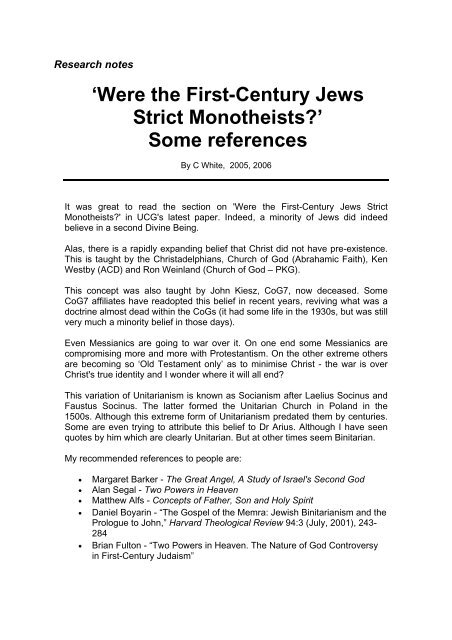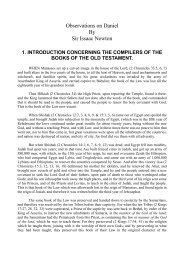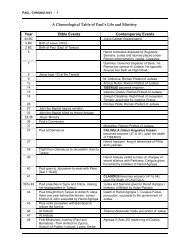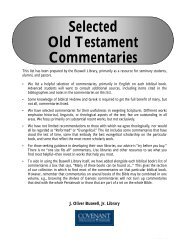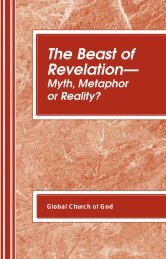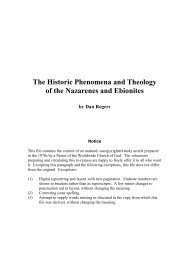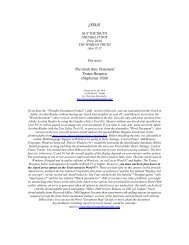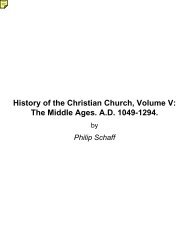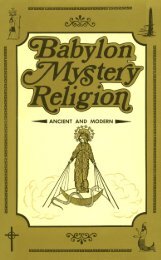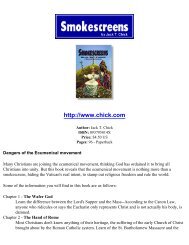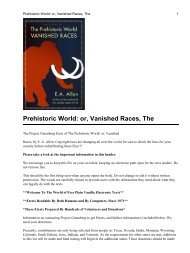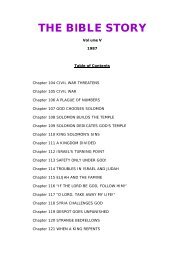Jews and Binitarianism.pdf - Friends of the Sabbath Australia
Jews and Binitarianism.pdf - Friends of the Sabbath Australia
Jews and Binitarianism.pdf - Friends of the Sabbath Australia
You also want an ePaper? Increase the reach of your titles
YUMPU automatically turns print PDFs into web optimized ePapers that Google loves.
Research notes<br />
‘Were <strong>the</strong> First-Century <strong>Jews</strong><br />
Strict Mono<strong>the</strong>ists?’<br />
Some references<br />
By C White, 2005, 2006<br />
It was great to read <strong>the</strong> section on 'Were <strong>the</strong> First-Century <strong>Jews</strong> Strict<br />
Mono<strong>the</strong>ists?' in UCG's latest paper. Indeed, a minority <strong>of</strong> <strong>Jews</strong> did indeed<br />
believe in a second Divine Being.<br />
Alas, <strong>the</strong>re is a rapidly exp<strong>and</strong>ing belief that Christ did not have pre-existence.<br />
This is taught by <strong>the</strong> Christadelphians, Church <strong>of</strong> God (Abrahamic Faith), Ken<br />
Westby (ACD) <strong>and</strong> Ron Weinl<strong>and</strong> (Church <strong>of</strong> God – PKG).<br />
This concept was also taught by John Kiesz, CoG7, now deceased. Some<br />
CoG7 affiliates have readopted this belief in recent years, reviving what was a<br />
doctrine almost dead within <strong>the</strong> CoGs (it had some life in <strong>the</strong> 1930s, but was still<br />
very much a minority belief in those days).<br />
Even Messianics are going to war over it. On one end some Messianics are<br />
compromising more <strong>and</strong> more with Protestantism. On <strong>the</strong> o<strong>the</strong>r extreme o<strong>the</strong>rs<br />
are becoming so ‘Old Testament only’ as to minimise Christ - <strong>the</strong> war is over<br />
Christ's true identity <strong>and</strong> I wonder where it will all end?<br />
This variation <strong>of</strong> Unitarianism is known as Socianism after Laelius Socinus <strong>and</strong><br />
Faustus Socinus. The latter formed <strong>the</strong> Unitarian Church in Pol<strong>and</strong> in <strong>the</strong><br />
1500s. Although this extreme form <strong>of</strong> Unitarianism predated <strong>the</strong>m by centuries.<br />
Some are even trying to attribute this belief to Dr Arius. Although I have seen<br />
quotes by him which are clearly Unitarian. But at o<strong>the</strong>r times seem Binitarian.<br />
My recommended references to people are:<br />
• Margaret Barker - The Great Angel, A Study <strong>of</strong> Israel's Second God<br />
• Alan Segal - Two Powers in Heaven<br />
• Mat<strong>the</strong>w Alfs - Concepts <strong>of</strong> Fa<strong>the</strong>r, Son <strong>and</strong> Holy Spirit<br />
• Daniel Boyarin - “The Gospel <strong>of</strong> <strong>the</strong> Memra: Jewish <strong>Binitarianism</strong> <strong>and</strong> <strong>the</strong><br />
Prologue to John,” Harvard Theological Review 94:3 (July, 2001), 243-<br />
284<br />
• Brian Fulton - “Two Powers in Heaven. The Nature <strong>of</strong> God Controversy<br />
in First-Century Judaism”
A Note: ‘Were <strong>the</strong> First-Century <strong>Jews</strong> Strict Mono<strong>the</strong>ists?’ Some References<br />
• James McGrath <strong>and</strong> Jerry Truex – “‘Two Powers’ <strong>and</strong> Early Jewish <strong>and</strong><br />
Christian Mono<strong>the</strong>ism”<br />
The Great Angel, A Study <strong>of</strong> Israel's Second God is a remarkable work that I<br />
somehow came across in <strong>the</strong> early or mid-1990s. It is highly recommended<br />
reading. The Two Powers in Heaven is ano<strong>the</strong>r excellent work I stumbled<br />
across in <strong>the</strong> University <strong>of</strong> Sydney library, around <strong>the</strong> early or mid-1990s. And<br />
Concepts <strong>of</strong> Fa<strong>the</strong>r, Son <strong>and</strong> Holy Spirit is one I found advertised somewhere<br />
<strong>and</strong> ordered it around 1987 or 1988. While <strong>the</strong> article “The Gospel <strong>of</strong> <strong>the</strong><br />
Memra: Jewish <strong>Binitarianism</strong> <strong>and</strong> <strong>the</strong> Prologue to John” I came across last year<br />
(2005) but could not find a copy in <strong>Australia</strong>. However, a kind member in <strong>the</strong><br />
USA found <strong>the</strong> article in a library <strong>and</strong> scanned it for me.<br />
Here are some quotes from Two Powers in Heaven which demonstrates that<br />
<strong>Binitarianism</strong> was a minority view amongst <strong>the</strong> <strong>Jews</strong>:<br />
“Though it was difficult to date <strong>the</strong> rabbinic traditions<br />
accurately in many cases, <strong>the</strong> results showed that <strong>the</strong><br />
earliest heretics believed in two complementary powers in<br />
heaven … At its beginning, Christianity was ra<strong>the</strong>r more<br />
“<strong>Binitarianism</strong>” than Trinitarian, emphasizing only Christ <strong>and</strong><br />
<strong>the</strong> Fa<strong>the</strong>r as God … There is warrant to believe that “two<br />
powers” heresy was manifested in some kinds <strong>of</strong><br />
Christianity in <strong>the</strong> first century. The evidence seems to<br />
show that Johannine Christianity , at least, was condemned<br />
by <strong>Jews</strong> as “di<strong>the</strong>ism” <strong>and</strong> would have considered itself to<br />
be “Binitarian” ” (pp. x, 7, 218).<br />
Now, I just hope we don't over-react to Socianism so that we put greater<br />
emphasis on Christ than <strong>the</strong> Fa<strong>the</strong>r. For instance, some have said that <strong>the</strong><br />
sabbath-observing groups over <strong>the</strong> ages chiefly proclaimed Christological<br />
connections to <strong>the</strong> holy days - this is inaccurate:<br />
1. The onus is on those making such claims to prove it;<br />
2. What we know <strong>of</strong> what was taught was more on <strong>the</strong>y are a ceremonial<br />
requirement <strong>and</strong> prophetic connections;<br />
3. IF <strong>the</strong>y taught mainly Christological connections in <strong>the</strong> past, why<br />
should we go back? We must go forward with deeper underst<strong>and</strong>ing<br />
because during this century we have witnessed an explosion in Biblical<br />
knowledge.<br />
The Scriptures indicate that knowledge shall increase in <strong>the</strong> end time<br />
(Dan. 12:4). This is <strong>of</strong>ten accomplished by building on <strong>the</strong> underst<strong>and</strong>ing,<br />
knowledge <strong>and</strong> research <strong>of</strong> predecessors. Not only is raw knowledge<br />
increased, but so is qualitative value-adding to doctrine with deeper <strong>and</strong><br />
more meaningful insights.<br />
2
A Note: ‘Were <strong>the</strong> First-Century <strong>Jews</strong> Strict Mono<strong>the</strong>ists?’ Some References<br />
4. Finally, it is <strong>the</strong> few Protestants that take an interest in feast day<br />
typology who chiefly see Christ in <strong>the</strong>m. Not us! And it is those within our<br />
various fellowships that have watered-down so many <strong>of</strong> our beliefs that<br />
want to preach Christ. He is indeed in <strong>the</strong> Holy Days, but that is not <strong>the</strong><br />
Biblical emphasis: He is <strong>the</strong> agent for <strong>the</strong> Fa<strong>the</strong>r to guide His Plan which<br />
is outlined in <strong>the</strong> Holy Days.<br />
That is <strong>the</strong> chief emphasis for <strong>the</strong>se days. Diminishing <strong>the</strong> Fa<strong>the</strong>r is not an<br />
option – yet it is being pushed from certain quarters. Why? What is <strong>the</strong>ir<br />
agenda? Who has authorized such a change in doctrinal emphasis anyway?<br />
The Nature <strong>of</strong> God <strong>and</strong> Christ<br />
Doctrinal Study Paper<br />
Approved by <strong>the</strong> Council <strong>of</strong> Elders<br />
August 2005<br />
Page 59<br />
September 2005<br />
© 2005 United Church <strong>of</strong> God, an International Association<br />
Appendix E<br />
Were <strong>the</strong> First-Century <strong>Jews</strong> Strict Mono<strong>the</strong>ists?<br />
One <strong>of</strong> <strong>the</strong> arguments against <strong>the</strong> deity <strong>of</strong> Christ is <strong>the</strong> argument from silence.<br />
This argument assumes that <strong>the</strong> <strong>Jews</strong> <strong>of</strong> Christ’s day were strictly mono<strong>the</strong>istic<br />
<strong>and</strong> if Christ had pr<strong>of</strong>essed to being God in <strong>the</strong> flesh this would have been a big<br />
issue at that time. But is it true that <strong>the</strong> <strong>Jews</strong> <strong>of</strong> <strong>the</strong> first century believed in<br />
“strict” mono<strong>the</strong>ism?<br />
There is no question but that <strong>the</strong> <strong>Jews</strong> were mono<strong>the</strong>istic, but how were <strong>the</strong>y<br />
mono<strong>the</strong>istic? In <strong>the</strong> past 30 years much new information has come to light that<br />
sheds doubt on <strong>the</strong> traditional view <strong>of</strong> Jewish belief about <strong>the</strong> Godhead. More<br />
<strong>and</strong> more evidence shows that <strong>the</strong> <strong>Jews</strong> did struggle with <strong>the</strong> issue <strong>of</strong> plurality<br />
in <strong>the</strong> Godhead.<br />
The Jewish Backgrounds <strong>of</strong> <strong>the</strong> New Testament: Second Commonwealth<br />
Judaism in Recent Study by J. Julius Scott, Jr. <strong>of</strong> <strong>the</strong> Wheaton College<br />
Graduate School shows clearly that it is a mistake to believe that <strong>the</strong> <strong>Jews</strong> <strong>of</strong><br />
<strong>the</strong> New Testament period were “strict mono<strong>the</strong>ists” <strong>and</strong> <strong>the</strong>y would never have<br />
accepted Jesus as God. Scott shows that <strong>the</strong> idea <strong>of</strong> “strict mono<strong>the</strong>ism” did not<br />
develop until <strong>the</strong> Middle Ages <strong>and</strong> was an attempt to stop <strong>the</strong> encroachment by<br />
Christianity. Here are some quotes from Scott:<br />
3
A Note: ‘Were <strong>the</strong> First-Century <strong>Jews</strong> Strict Mono<strong>the</strong>ists?’ Some References<br />
The immediate Jewish background <strong>of</strong> <strong>the</strong> New Testament was shaped by three<br />
cataclysmic events <strong>and</strong> <strong>the</strong>ir results as various groups <strong>of</strong> <strong>Jews</strong> reacted to <strong>the</strong>m<br />
differently.<br />
First came <strong>the</strong> destruction <strong>of</strong> <strong>the</strong> Jewish state by <strong>the</strong> Babylonians in 587/6 BCE.<br />
The Hebrews lost <strong>the</strong>ir l<strong>and</strong>, monarchy, holy city <strong>and</strong> temple <strong>and</strong> were scattered<br />
throughout <strong>the</strong> world. Consequently, <strong>the</strong>y faced a <strong>the</strong>ological crisis involving <strong>the</strong><br />
nature, power, <strong>and</strong> goodness <strong>of</strong> God. They were also threatened culturally,<br />
racially, <strong>and</strong> ceremonially as <strong>the</strong>y were thrown into proximity with o<strong>the</strong>r peoples<br />
<strong>and</strong> religious groups. In addition, <strong>the</strong> absence <strong>of</strong> recognized prophets left <strong>the</strong><br />
Hebrews without divine guidance at a time when <strong>the</strong>y felt most in need <strong>of</strong><br />
support <strong>and</strong> direction.<br />
Debate <strong>and</strong> disagreement continue about many facts <strong>and</strong> interpretations <strong>of</strong> <strong>the</strong><br />
remains <strong>of</strong> Second Temple Judaism. Yet, something <strong>of</strong> a general agreement on<br />
a number <strong>of</strong> significant points has emerged. This includes new underst<strong>and</strong>ings,<br />
recognitions <strong>of</strong> previously obscure facts <strong>and</strong> emphases, <strong>and</strong> changed opinions.<br />
Some <strong>of</strong> <strong>the</strong> more important elements in this “new consensus” may be<br />
described as follows.<br />
1. Intertestamental Judaism is a descendant <strong>of</strong> <strong>the</strong> Old Testament Hebrew faith<br />
<strong>and</strong> culture but is not identical with it… [Also we] must distinguish it from<br />
Rabbinic Judaism, which developed after <strong>the</strong> destruction <strong>of</strong> Jerusalem, <strong>the</strong><br />
temple, <strong>and</strong> <strong>the</strong> Jewish state. This distinction must be carefully noted in, among<br />
o<strong>the</strong>r things, attempting to use certain types <strong>of</strong> source materials, especially <strong>the</strong><br />
Old Testament <strong>and</strong> Rabbinic writings, as witnesses to <strong>the</strong> faith <strong>and</strong> practices <strong>of</strong><br />
this period.<br />
2. Although Second Commonwealth Judaism had cardinal tenets, such as<br />
mono<strong>the</strong>ism [which was not clearly defined], covenant, Torah, <strong>and</strong> <strong>the</strong><br />
implications <strong>of</strong> <strong>the</strong>se, it was essentially a religion <strong>of</strong> orthopraxy ra<strong>the</strong>r than<br />
orthodoxy. Behavior <strong>and</strong> practice, not precise <strong>the</strong>ological subscription,<br />
demonstrated faithfulness to <strong>the</strong> national or sectarian commitment.<br />
3. The society, culture, faith <strong>and</strong> practice <strong>of</strong> Intertestamental Judaism were far<br />
from a monolithic whole. As we have already mentioned diversity was a major<br />
characteristic <strong>of</strong> <strong>the</strong> society <strong>and</strong> period; accordingly it is folly to seek a mainline<br />
or correct position or to assume that one particular group or trajectory can be<br />
identified as <strong>the</strong> “normative Judaism” <strong>of</strong> <strong>the</strong> period. The diverse elements which<br />
made up <strong>the</strong> fabric <strong>of</strong> Intertestamental Jewish society must be taken into<br />
account, both individually <strong>and</strong> toge<strong>the</strong>r, in attempting to underst<strong>and</strong> <strong>the</strong> period.<br />
4. Our “new consensus” sees Second Temple Judaism, not as a “holding<br />
pattern” between <strong>the</strong> Jewish <strong>and</strong> Christian Scriptures, but as a dynamic<br />
civilization which faced <strong>and</strong> was given form by its response(s) to genuine<br />
tensions arising from political, cultural, sociological, existential, <strong>and</strong> religious<br />
situations <strong>and</strong> issues. This challenge took place within <strong>the</strong> context <strong>of</strong><br />
commitment, on <strong>the</strong> one h<strong>and</strong>, to <strong>the</strong> abiding relevance <strong>of</strong> Jewish socionationalistic-religious<br />
heritage, as it was <strong>the</strong>n understood, <strong>and</strong>, on <strong>the</strong> o<strong>the</strong>r<br />
4
A Note: ‘Were <strong>the</strong> First-Century <strong>Jews</strong> Strict Mono<strong>the</strong>ists?’ Some References<br />
h<strong>and</strong>, to <strong>the</strong> need to face realistically <strong>the</strong> changing circumstances <strong>of</strong> life in <strong>the</strong><br />
world in which <strong>the</strong>y lived.1[64]<br />
Samson H. Levey, in The Messiah: An Aramaic Interpretation: The Messianic<br />
Exegesis <strong>of</strong> <strong>the</strong> Targum published by Hebrew Union College in Cincinnati in<br />
1974, fur<strong>the</strong>r confirms this diversity in Jewish thought in <strong>the</strong> time <strong>of</strong> <strong>the</strong> first<br />
century when it came to <strong>the</strong> Messiah. There is evidence that would include <strong>the</strong><br />
Messiah being “divine” or God.<br />
The diversity <strong>of</strong> this period is probably no where more evident than in<br />
eschatological expectations. Would <strong>the</strong> Consummation be simultaneous with or<br />
subsequent to <strong>the</strong> arrival <strong>of</strong> <strong>the</strong> Final Age? Would <strong>the</strong>re be a divine agent (a<br />
Messiah), or would God personally intervene? If <strong>the</strong> former, would <strong>the</strong> Messiah<br />
be human, spiritual-angelic, or divine? Is <strong>the</strong> “Messiah” a personal, corporate, or<br />
idealized figure? Would <strong>the</strong>re be a single Messianic figure or several? Would<br />
<strong>the</strong> role or task <strong>of</strong> <strong>the</strong> Messiah or Messiahs be primarily political, military, social,<br />
or religious? Would he be concerned solely for <strong>the</strong> affairs <strong>of</strong> <strong>the</strong> Hebrews or<br />
would he also benefit Gentiles <strong>and</strong> <strong>the</strong> natural order? What would be <strong>the</strong> status<br />
<strong>of</strong> Temple <strong>and</strong> Torah during <strong>the</strong> Final Age, <strong>of</strong> various Jewish groups, <strong>of</strong> <strong>the</strong><br />
Gentiles? Although <strong>the</strong> majority <strong>of</strong> common people in The L<strong>and</strong> <strong>of</strong> Israel (<strong>the</strong><br />
“Am Ha-Eretz” or “Average <strong>Jews</strong>”) seem to have held to some loosely defined<br />
hope <strong>of</strong> an essentially military-political-nationalistic Messiah(s) who would both<br />
deliver from enemies <strong>and</strong> enable God’s people to “serve him without fear in<br />
holiness <strong>and</strong> righteousness,” it is impossible to speak categorically about “<strong>the</strong><br />
single pre-Christian Jewish belief” <strong>of</strong> almost anything [emphasis added].2[65]65<br />
Survey <strong>of</strong> <strong>the</strong> New Testament—Intertestamental Judaisms by Thomas L. Long<br />
has this to say about Judaism <strong>of</strong> <strong>the</strong> first century <strong>and</strong> just prior:<br />
The period between <strong>the</strong> second century BCE <strong>and</strong> <strong>the</strong> second century CE is<br />
known to biblical historians as <strong>the</strong> “Intertestamental Period,” that is it marked<br />
<strong>the</strong> closure <strong>of</strong> <strong>the</strong> canon <strong>of</strong> <strong>the</strong> Hebrew scriptures <strong>and</strong> <strong>the</strong> formation <strong>of</strong> <strong>the</strong><br />
canon <strong>of</strong> <strong>the</strong> Christian scriptures.<br />
This period is important to <strong>Jews</strong> because it includes <strong>the</strong> devastating Jewish<br />
revolt against <strong>the</strong> Roman empire, which resulted in <strong>the</strong> destruction <strong>of</strong> <strong>the</strong><br />
Second Temple <strong>and</strong> <strong>the</strong> end <strong>of</strong> sacrificial worship, <strong>and</strong> it is important to<br />
Christians because it represents <strong>the</strong> matrix in which Jesus <strong>of</strong> Nazareth <strong>and</strong> his<br />
earliest disciples were formed. Because it was a period <strong>of</strong> tremendous<br />
<strong>the</strong>ological diversity within Jewish practice, recent scholars <strong>of</strong> religion have<br />
tended to characterize it in <strong>the</strong> plural—Judaisms—ra<strong>the</strong>r than representing it as<br />
a single monolithic religious orthodoxy. What we know about this period comes<br />
from several sources: <strong>the</strong> Christian scriptures (not a particularly reliable<br />
historical document because <strong>the</strong>y were <strong>of</strong>ten hostile to Jewish authorities), <strong>the</strong><br />
1[64] J. Julius Scott, Jr., The Jewish Backgrounds <strong>of</strong> <strong>the</strong> New Testament: Second<br />
Commonwealth Judaism in Recent Study.<br />
2[65] Samson H. Levey, The Messiah: An Aramaic Interpretation: The Messianic Exegesis <strong>of</strong><br />
<strong>the</strong> Targum, Cincinnati: Hebrew Union College, 1974.<br />
5
A Note: ‘Were <strong>the</strong> First-Century <strong>Jews</strong> Strict Mono<strong>the</strong>ists?’ Some References<br />
first-century Jewish historian Flavius Josephus <strong>and</strong> <strong>the</strong> philosopher Philo <strong>of</strong><br />
Alex<strong>and</strong>ria, <strong>the</strong> Dead Sea Scrolls, archeological remains, <strong>and</strong> inscriptions.3[66]<br />
In “Mono<strong>the</strong>ism—A Misused Word in Jewish Studies?” Peter Hayman states:<br />
In <strong>the</strong> academic world <strong>of</strong> twenty or thirty years ago it was conventional to hold<br />
that <strong>the</strong> story <strong>of</strong> Judaism was one <strong>of</strong> a gradual, but inexorable, evolution from a<br />
Canaanite/Israelite pagan <strong>and</strong> mythological environment into <strong>the</strong> pure light <strong>of</strong> an<br />
unsullied mono<strong>the</strong>ism. It is hardly ever appropriate to use <strong>the</strong> term mono<strong>the</strong>ism<br />
to describe <strong>the</strong> Jewish idea <strong>of</strong> God, that no progress beyond <strong>the</strong> simple<br />
formulas <strong>of</strong> <strong>the</strong> Book <strong>of</strong> Deuteronomy can be discerned in Judaism before <strong>the</strong><br />
philosophers <strong>of</strong> <strong>the</strong> Middle Ages, <strong>and</strong> that Judaism never escapes from <strong>the</strong><br />
legacy <strong>of</strong> <strong>the</strong> battles for supremacy between Yahweh, Ba’al <strong>and</strong> El from which it<br />
emerged.4[67]<br />
It is also quite revealing to read <strong>the</strong> writings <strong>of</strong> <strong>the</strong> early writers as to how <strong>the</strong>y<br />
viewed Christ. Ignatius (A.D. 110 to 117) wrote in his epistle to <strong>the</strong> Ephesians:<br />
“By <strong>the</strong> will <strong>of</strong> <strong>the</strong> Fa<strong>the</strong>r <strong>and</strong> <strong>of</strong> Jesus Christ, our God… God Himself being<br />
manifested in human form.” In his epistle to <strong>the</strong> Trallians he writes: “Jesus our<br />
God.” In his epistle to <strong>the</strong> Romans: “Jesus Christ our God.” In Magnesians 6,<br />
Ignatius writes: “Jesus was with <strong>the</strong> Fa<strong>the</strong>r before <strong>the</strong> beginning <strong>of</strong> time…”<br />
Polycarp was ano<strong>the</strong>r early writer. In his epistle to <strong>the</strong> Philippians he wrote<br />
about Jesus Christ as “God <strong>and</strong> our Lord.” This is fur<strong>the</strong>r pro<strong>of</strong> that <strong>the</strong> <strong>Jews</strong><br />
<strong>and</strong> <strong>the</strong> Christians <strong>of</strong> <strong>the</strong> first century did have a grasp <strong>of</strong> <strong>the</strong> concept <strong>of</strong> plurality<br />
in <strong>the</strong> Godhead. While <strong>the</strong>y were mono<strong>the</strong>istic, one needs to explain exactly<br />
what is meant by <strong>the</strong> term. There was clearly room in <strong>the</strong>ir <strong>the</strong>ology for Christ to<br />
be God.<br />
History Research Projects<br />
www.origin<strong>of</strong>nations.org<br />
No limitation is placed upon reproduction <strong>of</strong> this document except that it must be reproduced<br />
in its entirety without modification or deletions. The publisher's name <strong>and</strong> web address,<br />
copyright notice <strong>and</strong> this message must be included. It may be freely distributed but must be<br />
distributed without charge to <strong>the</strong> recipient.<br />
3[66] Thomas L. Long, Survey <strong>of</strong> <strong>the</strong> New Testament—Intertestamental Judaisms.<br />
4[67] Peter Hayman, “Mono<strong>the</strong>ism—A Misused Word in Jewish Studies?” Journal <strong>of</strong> Jewish<br />
Studies, Vol. 42, 1991.<br />
6


